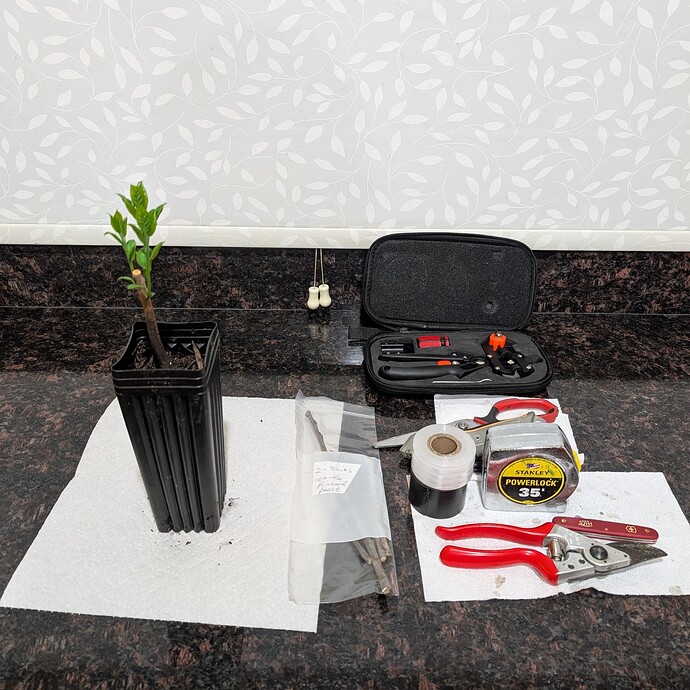Look at the zenport tool reviewed here, I’ve grabbed 2 for around $30 each. I’ve heard the Italian style one is good too. There’s a homemade version using utility knife blades shared on the forum, I believe by @applenut
The Italian tool is very good for W (omega) grafts, if your wood is large enough.
Two weeks ago I trimmed those rootstocks to about 5" above the soil. Two of them popped leaf buds the other day and one of them is growing rapidly! So today I matched up one of the 100-46 scions I received from Dax and grafted them together.
I used my grafting tool to make matching V cuts in the wood and wrapped them together with parafilm. Afterwards I attached a piece of #2242 linerless electrical tape lengthwise for structural support.
I’m trusting your not forgetting todays breeders, as you seem to strive to be on the cutting edge of modern tasty persimmons. I live about an hours drive from Cliff England, and so am a regular visitor, August thru November. There are some tasty morsels there, besides Kumie’s homemade cinnamon rolls! Succulent, MP-3, Huma. Whopper, UKR 12-21, UKR 15-9 and other of his researched and unnamed Asian varieties. Just a thought. Thanks
@Jobe
Thanks for your thoughts. This thread is about the American persimmons I’m growing in California. There are import restrictions prohibiting incoming shipments of Diospyros rootstock. Production nurseries here are focused on D. kaki and D. lotus rootstock for Asian and Hybrid persimmons. D. virginiana is currently not sold as a rooted tree in California. However, one can buy D. virginiana rootstock from Fruitwood nursery in Orleans CA and import scionwood from members and retailers outside of the state. I have 18 rootstocks to which I’m grafting multiple instances of Morris Burton, Geneva Red, Prairie Star, Lehman’s Delight (100-46), DEC Valeene Queen, and Downingtown Center. I plan to trial them for the next 5-10 years to see how they perform in my zone 10b coastal influenced climate. Elsewhere I have discussed the Asian and hybrid persimmons I’m growing here.
@Richard
I suggest that you remove the “nurse branch”.
D. Virginiana given the opportunity will grow around the graft ultimately causing graft failure.
@JCW
Thanks for the tip. I was curious about this. Nurse branches are a necessary part of grafting some tropicals, e.g. Mango. They are removed once activity begins in the scion. But Diospyros are of course a whole different beast.
My success rate with the D. virginiana cleft grafts appears to be 10%. Part of this might have been due to starting too early. The plants are far more vigorous now than when I grafted. It is certainly a different experience in comparison to citrus, fig, and avocado.
Since I have unused rootstocks, I’m going to try harvesting mega-buds from the failed scions and placing them in the unused stocks. Regardless of what happens, I’ll still have rootstocks to play with again next Spring ![]() .
.
Here’s a photo of the 9 failed grafts plus the 6 unused rootstocks behind them.










